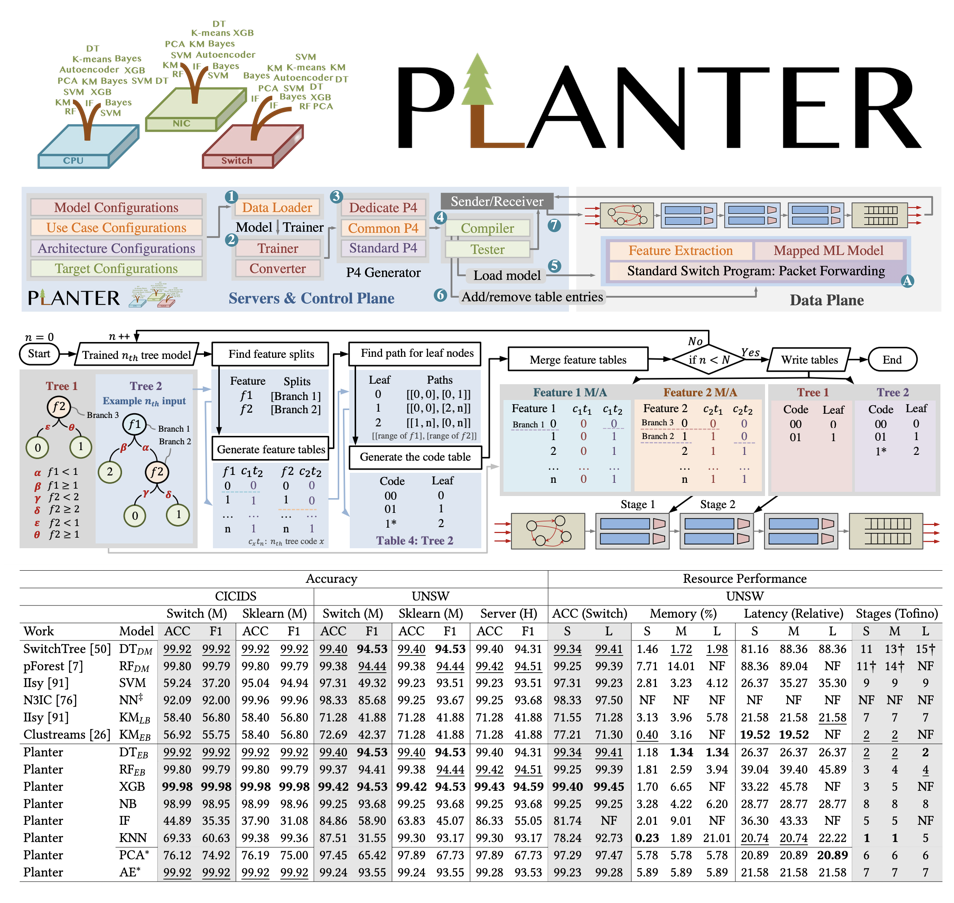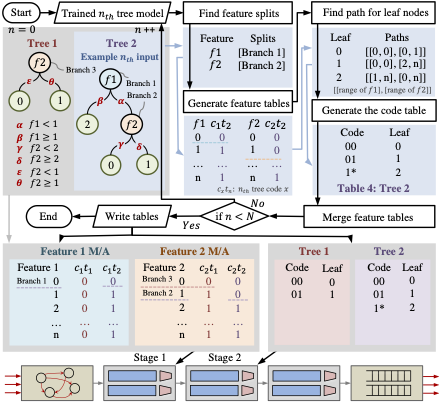|
Home | Publications | Service | Teaching | Honors | Google Scholar | GitHub | WeChat | Twitter
|

|
COM4AI, Talk, Nov 19th, 2026. Planter | IIsy | DINC| Link| ... | Code The rapid surge in ML demand has led to soaring computational workloads and escalating data volumes, creating substantial challenges for traditional architectures. In-network machine learning emerges as a promising and scalable alternative. This talk introduced its concept, core technologies, and implementation strategies. |

|
Kaiyi Zhang, Changgang Zheng, Nancy Samaan, Ahmed Karmouch, and Noa Zilberman IEEE HPSR 2025 [CCF B] [Best Paper] Paper | Link | BibTex We introduce MUTA; a novel in-network multi-task learning solution. MUTA enables executing multiple inference tasks concurrently in the data-plane, without exhausting available resources. |

|
StarLab Group Seminar, Tsinghua University, Talk, Sep 30th, 2024 Planter | IIsy | DINC| ... | Code This presentation will introduce the concept of in-network machine learning, the technology and its implementation, including three general model mapping methodologies. As in-network machine learning is a resource-constrained machine learning problem, two solutions will be introduced: a distributed deployment, and a hybrid deployment solution. |

|
Changgang Zheng, Mingyuan Zang, Xinpeng Hong, Liam Perreault, Riyad Bensoussane, Shay Vargaftik, Yaniv Ben-Itzhak, and Noa Zilberman ACM SIGCOMM Computer Communication Review (CCR), 2024 [Acceptance rates comparable to ACM SIGCOMM conference, i.e., under 15%] [Best of CCR] Video | PDF | arXiv (2022) | BibTex | Code | Doc Using programmable network devices to aid in-network machine learning has been the focus of significant research. This work presents Planter, an open-source, modular framework for mapping trained machine learning models to programmable devices. Planter supports a wide range of machine learning models, multiple targets and can be easily extended. |

|
Computing Infrastructure Group, Tutorial, Mar 14th, 2024 P4 | BMv2 | v1model | P4Pi This tutorial introduces programmable network devices and P4. The tutorial focuses on programming the P4 platform (v1model architecture and BMv2 Simple Switch target). Specifically, the platform is the Raspberry Pi powered by P4Pir. |

|
Guest lecture, Mar 7th, 2024 UiT | LinkedIn | Slides | Planter | IIsy | DINC This guest lecture is invited by Dr. Masoud Hemmatpour from UiT. The presentation will include the concept and benefits of in-network machine learning, algorithm mappings, hybrid and distributed deployment strategies, as well as several use cases. |

|
TCCN Security SIG’s Monthly Virtual Rising Star Symposium Seminar, Talk, Feb 13th, 2024 TCCN’s Sec-IG | Slides | Planter | IIsy | DINC This presentation will introduce the concept of in-network machine learning, the technology and its implementation, including three general model mapping methodologies. As in-network machine learning is a resource-constrained machine learning problem, two solutions will be introduced: a distributed deployment, and a hybrid deployment solution. |

|
P4.org Open Source Developer Days, Talk, Jan 9th, 2024 P4.org | Paper | BibTex | Code In this presentation, I presents DINC, a framework enabling distributed in-network computing, generating deployment strategies, overcoming resource constraints and providing functionality guarantees across a network. |

|
UCL ICCS Huawei Workshop, Talk, 14th Dec, 2023 UCL Huawei Workshop | Planter | Extended Planter | DINC | ... | BibTex This workshop brings together world-renowned experts in networking and AI to explore the exciting interplay of both to present and discuss cutting-edge developments... My presentation in this workshop mainly summarises two works, Planter and DINC, related to In-network machine learning. |

|
19th ACM CoNEXT, Talk, Dec 6th, 2023 ACM CoNEXT'23 | Paper | BibTex | Code In this presentation, I presents DINC, a framework enabling distributed in-network computing, generating deployment strategies, overcoming resource constraints and providing functionality guarantees across a network.. |

|
Group Seminar, University of Cambridge, Talk, Nov 23th, 2023 Computer Laboratory Systems Research Group Seminar series | Paper | BibTex | Code In this presentation, I presents DINC, a framework enabling distributed in-network computing, generating deployment strategies, overcoming resource constraints and providing functionality guarantees across a network.. |

|
2nd ACM SIGCOMM Workshop on FIRA, Talk, 10th September, 2023 Paper | BibTex | Slides Future of Internet Routing & Addressing (FIRA) includes works on use cases, design principles, architectures, and techniques, as well as insights into implementations and experiments with novel solutions that address the highlighted objectives. Our QCMP presentation focuses on designing in-network Q-learning for data centre load balancing. |

|
Coseners, 35th Multi-Service Networks workshop (MSN 2023), Talk, 13th July, 2023 Planter | Extended Planter | Extended IIsy | Linnet | P4Pir | FLIP4 | LOBIN | ... | BibTex Coseners is one of the important events for the UK networking society. This year, my presentation (a summary of my DPhil) includes all the work I (and the Computing Infrastructure Group, Oxford) have done related to In-network machine learning. |

|
MobiUK, Jul 3rd-4th, 2023 P4Pir | Paper | Slides | BibTex IoT devices are widely and dynamically deployed in diverse use cases, leading to a surge of security threats that were previously overlooked. We propose P4Pir, an in-network traffic analysis solution, to enable continuous learning and consistent ML updates. P4Pir achieves real-time multi-protocol data collection, in-network ML-based attack mitigation, and hitless runtime ML updates. |

|
Group Seminar, Simula Research Laboratory, Talk, Jun 21st, 2023 Planter | Extended Planter | Extended IIsy | Linnet | P4Pir | FLIP4 | LOBIN | BibTex This presentation elucidates in-network machine learning methodologies, solutions of each model, the design of the Planter framework, the hybrid deployment technique, evaluations, as well as their applications. |

|
COINRG (IRTF), IETF 115, Talk, London, Nov 8th, 2022 Video | Extended IIsy | Planter | Extended Planter | Linnet | P4Pir | BibTex This presentation will address real world challenges faced by in-network inference (limited resources, co-existing with core switch functionality, ML performance, retraining and others) and explain how we solved them. |

|
Group Seminar, Massachusetts Institute of Technology, Talk, Sep 27th, 2022 Link to IIsy | Extended IIsy | Planter Poster | Extended Planter | BibTex In this presentation, I introduced our in-network machine learning inference research during the past several years, ranging from IIsy and Planter to P4Pir and Linnet. |

|
Group Seminar, Princeton University, Talk, Sep 16th, 2022 Link to IIsy | Extended IIsy | Planter Poster | Extended Planter | BibTex In this presentation, I introduce in-network ML and its applications on smart IoT gateways and accelerating financial transactions. The evaluation shows that in-network ML have minor accuracy loss and can achieve near-optimal classification results, while significantly reducing latency and load on the servers. |

|
Group Seminar, Yale Institute for Network Science (YINS), Yale University, Talk, Jun 28th, 2022 Paper | BibTex This work designs Planter, a novel approach, which automatically and efficiently maps ML models to run within off-the-shelf network devices. My research will promote the practical application of network devices as ML accelerators to increase performance and reduce the load on computing infrastructure. |

|
Human-Machine Collaboration Programme, Poster, Apr 28th, 2022 Poster | BibTex This work designs Planter, a modular framework to offload Machine Learning algorithms to programmable networked devices, which enable the internet to provide Machine Learning inference services on programmable network devices. This will revolutionise the way we use the internet for Machine Learning. |

|
Participation, Oct 19th–21th, 2022 About 80 academic attendees and 80 Googler attendees. Our goal for this workshop is to expose academic researchers to the technical challenges that Google is facing, as well as some of the real-world constraints we operate under. Just as important, the workshop will give a chance to faculty in computer networking (and related areas) to expose their own new or early-stage work to each other, and to the Googlers who will be attending. |

|
Electrical Engineering Seminar, University of Oxford, Talk, Oct 26th, 2021 Paper | BibTex This work designs Planter, an algorithm for efficient mapping of machine learning models to programmable data planes. Planter increases the number of trees that can be mapped to a network device by overlapping trees within feature tables. And Planter can also support several different traditional models. |

|
The 33rd Multi-Service Networks workshop (MSN'21), Talk, Jul 1st, 2021 Slides | Short Video | BibTex This work design an algorithm for efficient mapping of ensemble models, such as XGBoost and Random Forest, to programmable switches. The proposed method overlaps trees within match-action tables, achieves high accuracy and low resource overhead. |